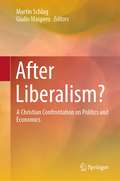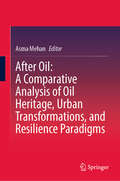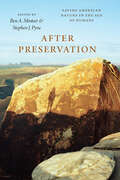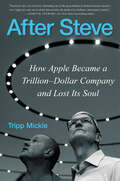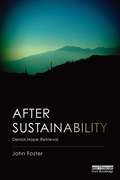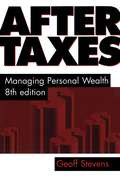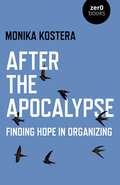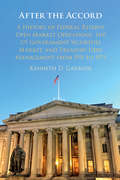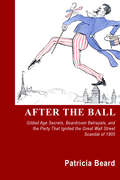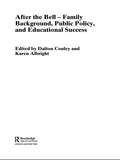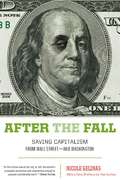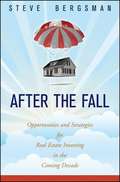- Table View
- List View
After Liberalism?: A Christian Confrontation on Politics and Economics
by Martin Schlag Giulio MasperoThe economic downturn caused by the COVID-19 pandemic, the unrest in the US following the unlawful death of George Floyd, and other sources of social unrest and insecurity, have brought to a head something that has been brewing in Western societies since the Great Recession of 2008: the disillusionment with liberal democracy as it evolved after World War II. Liberal political systems were characterized by a working compromise between capital and labor, between liberalism and socialism. This book analyzes how, and to what extent, the rise of populism and “identitarian” political movements, as well as the acceptance of world leaders who embody an authoritarian style of government, has undermined this compromise. Written by scholars from various disciplines, all of which share the Christian faith, it offers a snapshot of an intellectual debate among Christians who are deeply concerned about the world they live in, and who share their constructive proposals for a way forward after “liberalism as we know it.” The contributors address topics such as Christian alternatives to liberalism and populism, challenges to post-liberalism, trans-liberalism, and relational anthropology. Accordingly, the book will appeal to scholars who wish to reflect on the order of our society, and to anyone who shares the view that it is high time to rethink liberalism.
After Net Neutrality: A New Deal for the Digital Age (The Future Series)
by Victor Pickard David Elliot BermanA provocative analysis of net neutrality and a call to democratize online communication This short book is both a primer that explains the history and politics of net neutrality and an argument for a more equitable framework for regulating access to the internet. Pickard and Berman argue that we should not see internet service as a commodity but as a public good necessary for sustaining democratic society in the twenty-first century. They aim to reframe the threat to net neutrality as more than a conflict between digital leviathans like Google and internet service providers like Comcast but as part of a much wider project to commercialize the public sphere and undermine the free speech essential for democracy. Readers will come away with a better understanding of the key concepts underpinning the net neutrality battle and rallying points for future action to democratize online communication.
After Oil : A Comparative Analysis of Oil Heritage, Urban Transformations, and Resilience Paradigms
by Asma MehanThis book offers an academic analysis of the concept of heritage within the realm of oil-related urban development. It focuses on the term 'heritage', with a specific emphasis on 'oil heritage', exploring its varied implications for urban futures. The book provides a nuanced understanding of heritage, discussing its different interpretations and values across cultural and environmental contexts. It examines the legacy of oil, assessing its role and impact on societies. It presents a balanced view, acknowledging both the economic benefits of oil in urban growth and the environmental and socio-economic issues it poses. This approach places oil heritage within a broader heritage context, critically evaluating its unique characteristics. The book also investigates how various cultures perceive and engage with the idea of oil heritage. It highlights the contrast between the political debates over oil in Western countries and the developmental challenges faced by emerging economies, showcasing the global variance in the concept of 'oil heritage'. Additionally, the narrative considers the changing role and meaning of oil over time, reflecting on its historical importance and the challenges it poses for the future, especially in transitioning to a post-oil era. Through its chapters, the book provides a critical examination of the interplay between oil, urban development, and heritage studies. It is designed to contribute to scholarly discourse in these areas, targeting academics, students, policymakers, and professionals interested in the intricate relationship between oil heritage and urban dynamics.
After Piketty: The Agenda for Economics and Inequality
by Heather Boushey J. Bradford Delong Marshall SteinbaumAre Thomas Piketty’s analyses of inequality on target? Where should researchers go from here in exploring the ideas he pushed to the forefront of global conversation? In After Piketty, a cast of economists and other social scientists tackle these questions in dialogue with Piketty, in what is sure to be a much-debated book in its own right.
After Preservation: Saving American Nature in the Age of Humans
by Ben A. Minteer Stephen J. PyneFrom John Muir to David Brower, from the creation of Yellowstone National Park to the Endangered Species Act, environmentalism in America has always had close to its core a preservationist ideal. Generations have been inspired by its ethos--to encircle nature with our protection, to keep it apart, pristine, walled against the march of human development. But we have to face the facts. Accelerating climate change, rapid urbanization, agricultural and industrial devastation, metastasizing fire regimes, and other quickening anthropogenic forces all attest to the same truth: the earth is now spinning through the age of humans. After Preservation takes stock of the ways we have tried to both preserve and exploit nature to ask a direct but profound question: what is the role of preservationism in an era of seemingly unstoppable human development, in what some have called the Anthropocene? Ben A. Minteer and Stephen J. Pyne bring together a stunning consortium of voices comprised of renowned scientists, historians, philosophers, environmental writers, activists, policy makers, and land managers to negotiate the incredible challenges that environmentalism faces. Some call for a new, post-preservationist model, one that is far more pragmatic, interventionist, and human-centered. Others push forcefully back, arguing for a more chastened and restrained vision of human action on the earth. Some try to establish a middle ground, while others ruminate more deeply on the meaning and value of wilderness. Some write on species lost, others on species saved, and yet others discuss the enduring practical challenges of managing our land, water, and air. From spirited optimism to careful prudence to critical skepticism, the resulting range of approaches offers an inspiring contribution to the landscape of modern environmentalism, one driven by serious, sustained engagements with the critical problems we must solve if we--and the wild garden we may now keep--are going to survive the era we have ushered in. Contributors include: Chelsea K. Batavia, F. Stuart (Terry) Chapin III, Norman L. Christensen, Jamie Rappaport Clark, William Wallace Covington, Erle C. Ellis, Mark Fiege, Dave Foreman, Harry W. Greene, Emma Marris, Michelle Marvier, Bill McKibben, J. R. McNeill, Curt Meine, Ben A. Minteer, Michael Paul Nelson, Bryan Norton, Stephen J. Pyne, Andrew C. Revkin, Holmes Rolston III, Amy Seidl, Jack Ward Thomas, Diane J. Vosick, John A. Vucetich, Hazel Wong, and Donald Worster.
After Redlining: The Urban Reinvestment Movement in the Era of Financial Deregulation (Historical Studies of Urban America)
by Rebecca K. MarchielAmerican banks, to their eternal discredit, long played a key role in disenfranchising nonwhite urbanites and, through redlining, blighting the very city neighborhoods that needed the most investment. Banks long showed little compunction in aiding and abetting blockbusting, discrimination, and outright theft from nonwhites. They denied funds to entire neighborhoods or actively exploited them, to the benefit of suburban whites—an economic white flight to sharpen the pain caused by the demographic one. And yet, the dynamic between banks and urban communities was not static, and positive urban development, supported by banks, became possible. In After Redlining, Rebecca K. Marchiel illuminates how, exactly, urban activists were able to change some banks’ behavior to support investment in communities that they had once abandoned. The leading activists arose in an area hit hard by banks’ discriminatory actions and politics: Chicago’s West Side. A multiracial coalition of low-and moderate-income city residents, this Saul Alinsky–inspired group championed urban reinvestment. And amazingly, it worked: their efforts inspired national action, culminating in the federal Home Mortgage Disclosure Act and the Community Reinvestment Act. While the battle for urban equity goes on, After Redlining provides a blueprint of hope.
After Revolution: Mapping Gender and Cultural Politics in Neoliberal Nicaragua
by Babb Florence E.Nicaragua's Sandinista revolution (1979-1990) initiated a broad program of social transformation to improve the situation of the working class and poor, women, and other non-elite groups through agrarian reform, restructured urban employment, and wide access to health care, education, and social services. This book explores how Nicaragua's least powerful citizens have fared in the years since the Sandinista revolution, as neoliberal governments have rolled back these state-supported reforms and introduced measures to promote the development of a market-driven economy. Drawing on ethnographic research conducted throughout the 1990s, Florence Babb describes the negative consequences that have followed the return to a capitalist path, especially for women and low-income citizens. In addition, she charts the growth of women's and other social movements (neighborhood, lesbian and gay, indigenous, youth, peace, and environmental) that have taken advantage of new openings for political mobilization. Her ethnographic portraits of a low-income barrio and of women's craft cooperatives powerfully link local, cultural responses to national and global processes.
After Sales Service: Zukunftsfähig und prozessorientiert gestalten
by Uwe Dombrowski Simon Fochler Constantin MalornyDer After Sales Service ist ein Unternehmensbereich, der zunehmend bedeutender für produzierende Unternehmen wird. Ziel des Buches ist es, Theorie und Praxis zusammenzuführen. Daher sollen Methodiken sowie praxis- und lösungsorientierte Handlungsempfehlungen gegeben werden, die es dem Leser ermöglichen, einen effektiven After Sales Service aufzubauen oder Unterstützung bei der After Sales Service-Einführung zu bekommen. Aus diesem Grund werden die drei Teilbereiche des After Sales Service auf theoretischer Basis detailliert beschrieben. Hierbei wird der Fokus auch auf die Serviceplanung als Querschnittsprozess zwischen strategischer Planung und operativer Ausführung des After Sales Service gelegt. Ferner wird der Paradigmenwechsel von der Funktionsorientierung hin zu einer Prozessorientierung beschrieben. Aber auch Trends, wie Service Transition oder Servitization, Geschäftsmodelle im Service, Lean After Sales Service, Globalisierung und die damit einhergehenden Folgen für das Service-Netzwerk oder die Entwicklungen im Rahmen der Industrie 4.0, wie zum Beispiel Smart Services, Anwendungen der Augmented Reality oder Predictive Maintenance. Außerdem werden neue Arten der Führung beschrieben, wie beispielsweise das Lean Leadership, die im After Sales Service genutzt werden können.
After Steve: How Apple Became a Trillion-Dollar Company and Lost Its Soul
by Tripp MickleFrom the Wall Street Journal’s Tripp Mickle, the dramatic, untold story inside Apple after the passing of Steve Jobs by following his top lieutenants—Jony Ive, the Chief Design Officer, and Tim Cook, the COO-turned-CEO—and how the fading of the former and the rise of the latter led to Apple losing its soul.Steve Jobs called Jony Ive his “spiritual partner at Apple.” The London-born genius was the second-most powerful person at Apple and the creative force who most embodies Jobs’s spirit, the man who designed the products adopted by hundreds of millions the world over: the iPod, iPad, MacBook Air, the iMac G3, and the iPhone. In the wake of his close collaborator’s death, the chief designer wrestled with grief and initially threw himself into his work designing the new Apple headquarters and the Watch before losing his motivation in a company increasingly devoted more to margins than to inspiration.In many ways, Cook was Ive’s opposite. The product of a small Alabama town, he had risen through the ranks from the supply side of the company. His gift was not the creation of new products. Instead, he had invented countless ways to maximize a margin, squeezing some suppliers, persuading others to build factories the size of cities to churn out more units. He considered inventory evil. He knew how to make subordinates sweat with withering questions.Jobs selected Cook as his successor, and Cook oversaw a period of tremendous revenue growth that has lifted Apple’s valuation to $2 trillion. He built a commanding business in China and rapidly distinguished himself as a master politician who could forge global alliances and send the world’s stock market into freefall with a single sentence.Author Tripp Mickle spoke with more than 200 current and former Apple executives, as well as figures key to this period of Apple’s history, including Trump administration officials and fashion luminaries such as Anna Wintour while writing After Steve. His research shows the company’s success came at a cost. Apple lost its innovative spirit and has not designed a new category of device in years. Ive’s departure in 2019 marked a culmination in Apple’s shift from a company of innovation to one of operational excellence, and the price is a company that has lost its soul.
After Sustainability: Denial, Hope, Retrieval
by John FosterDangerous climate change is coming. Some people still deny that it is happening. Others refuse to recognise that it is now too late to prevent it. But both these reactions spring from the same source: our pathological attachment to ‘progress’, of which sustainability has been one more version. After Sustainability traces that attachment to its roots in the ways we make sense of ourselves. Original and accessible, this is philosophy on the edge, written for anyone who glimpses our environmental tragedy and cares about our future. Does the challenge to stop pretending offer our only remaining chance? Read this book and make up your own mind.
After Taxes: Managing Personal Wealth 8th Edition
by Geoff StevensMaximizing one’s savings is the surest way to guarantee that there is life after taxes. The truly successful investor begins with careful tax planning, which must never be a last-minute scramble in the dreadful month of March or worse still, April! We all know that few of us actually plan well ahead, as we ought to, to protect ourselves and our hard-earned money. This book may well be the answer. Based on The Gasletter Collection, the author’s successful primer on sheltering your income, After Taxes is designed to help the working individual put in place a long-term strategy. An easy-to-understand handbook, it helps the reader wrestle with the implications of retirement funds, savings, off-shore shelters, investments, mutual funds, real estate, buyouts, separation allowances, and golden (or not-so-golden) handshakes. A must for those who wish to make informed financial decisions and better choices to guarantee a secure future.
After The Apocalypse: Finding Hope in Organizing
by Monika KosteraOur times of crumbling structures and decaying social bonds are often depicted as apocalyptic. This book takes the apocalypse as a metaphor to help us in the search for meaning in our everyday realities. Yes, the apocalypse is when social structures and institutions fall apart and we are terrified and suffocated by the debris raining down upon us. But 'apocalypse' also means 'revelation'. The very collapse reveals what dissipating institutions were constructed upon: where there ought to have been foundational common values, most often there is violence and raw power. Yet the values are there, too, and they can be found. This book is a guide to these values, showing how they can be of help to organizers and organizational dreamers.
After The End: Making U.S. Foreign Policy in the Post-Cold War World
by James M. ScottIn the political landscape emerging from the end of the Cold War, making U. S. foreign policy has become more difficult, due in part to less clarity and consensus about threats and interests. In After the End James M. Scott brings together a group of scholars to explore the changing international situation since 1991 and to examine the characteristics and patterns of policy making that are emerging in response to a post-Cold War world. These essays examine the recent efforts of U. S. policymakers to recast the roles, interests, and purposes of the United States both at home and abroad in a political environment where policy making has become increasingly decentralized and democratized. The contributors suggest that foreign policy leadership has shifted from White House and executive branch dominance to an expanded group of actors that includes the president, Congress, the foreign policy bureaucracy, interest groups, the media, and the public. The volume includes case studies that focus on China, Russia, Bosnia, Somalia, democracy promotion, foreign aid, and NAFTA. Together, these chapters describe how policy making after 1991 compares to that of other periods and suggest how foreign policy will develop in the future. This collection provides a broad, balanced evaluation of U. S. foreign policy making in the post-Cold War setting for scholars, teachers, and students of U. S. foreign policy, political science, history, and international studies. Contributors. Ralph G. Carter, Richard Clark, A. Lane Crothers, I. M. Destler, Ole R. Holsti, Steven W. Hook, Christopher M. Jones, James M. McCormick, Jerel Rosati, Jeremy Rosner, John T. Rourke, Renee G. Scherlen, Peter J. Schraeder, James M. Scott, Jennifer Sterling-Folker, Rick Travis, Stephen Twing
After Work Balance: Die Perspektiven der Älteren (essentials)
by Dietmar GoldammerWir werden immer älter, und viele Menschen sind beim Eintritt in den Ruhestand noch fit und möchten eine Tätigkeit ausüben, die ihnen Freude bereitet und für andere Nutzen stiftet. Dietmar Goldammer klärt auf, regt an und mobilisiert. Unterschiedliche individuelle Voraussetzungen erfordern unterschiedliche Strategien für eine veränderte Lebenssituation der älteren Menschen, und der Autor informiert mit zahlreichen Beispielen darüber, wie andere diese Situation erfolgreich gelöst haben. Zuvor stellt er dar, wie man sich auf den Ruhestand vorbereiten kann, welche Möglichkeiten es gibt und worauf man achten sollte. Auf diese Weise wird deutlich, dass man auch nach der Pensionierung noch erstrebenswerte Ziele erreichen kann.
After Work: A History of the Home and the Fight for Free Time
by Helen Hester Nick SRNICEKA timely manifesto for a feminist post-work politicsDoes it ever feel like you have no free time? You come home after work and instead of finding a space of rest and relaxation, you&’re confronted by a pile of new tasks to complete – cooking, cleaning, looking after the kids, and so on.In this ground-breaking book, Helen Hester and Nick Srnicek lay out how unpaid work in our homes has come to take up an ever-increasing portion of our lives – how the vacuum of free time has been taken up by vacuuming. Examining the history of the home over the past century – from running water to white goods to smart homes – they show how repeated efforts to reduce the burden of this work have faced a variety of barriers, challenges, and reversals.Charting the trajectory of our domestic spaces over the past century, Hester and Srnicek consider new possibilities for the future, uncovering the abandoned ideas of anti-housework visionaries and sketching out a path towards real free time for all, where everyone is at liberty to pursue their passions, or do nothing at all. It will require rethinking our living arrangements, our expectations and our cities.
After a Life-Threatening Diagnosis...What's Next?: A New Approach to Improve Healing Potential, Communications, and Life Quality
by Carolyn HornblowThis book should prove valuable in relieving stress and anxiety, especially important nowadays as the journey from diagnosis to cure or death is longer due to improvements in medical treatments. Healthcare workers and the general public worldwide would benefit as death is universal. The writing style is engaging and easy to read, yet highly informative. I would recommend this book to my patients and their families and friends. Dr. Suzanne Ward BMED FRAGP General Medical Practitioner Canberra, Australia This easy to read manual is invaluable reading following a life-threatening medical diagnosis. It is a comprehensive, clear and concise guide which can help reduce stress and improve healing potential. Written by a Registered Nurse (ret) who worked in the USA, UK, and Australia, she discusses why expressing fears soon after diagnosis can be beneficial for healing. Whatever the diagnosis, Cancer, Heart Attack, Stroke, Parkinson’s Disease, etc., you, your family, friends and colleagues will have worries and fears about your future. Reducing fears and stress early on gives more positive room for healing. This manual is indispensable for Doctors and Nurses, encouraging them to learn why and how discussing fears early on is a positive healing opportunity rather than being negative. Various complementary therapies are discussed to use in combination with traditional medicine, maximizing healing opportunities. While we plan for births and marriages, we find it difficult to talk and plan for our deaths, even though none of us escapes it! This book provides tools and suggestions for preparing Wills, Advanced Directives, and listing assets and wishes at whatever age, the sooner the better. Being prepared makes life so much easier for all. Learn how to live a more content, peaceful life alongside your family, friends, neighbors and globally. Life is not a dress rehearsal. Learn how to live fully NOW.
After the Accord: A History of Federal Reserve Open Market Operations, the US Government Securities Market, and Treasury Debt Management from 1951 to 1979 (Studies in Macroeconomic History)
by Kenneth D. GarbadeIn this book Garbade, a former analyst at a primary dealer and researcher at the Federal Reserve Bank of New York, traces the evolution of open market operations, Treasury debt management, and the microstructure of the US government securities markets following the 1951 Treasury-Federal Reserve. This volume examines how these operations evolved, responding both to external forces and to one another. Utilising a vast scope of primary material, the work provides insight into how officials fashioned the instruments, facilities, and procedures needed to advance their policy objectives in light of their novel freedoms and responsibilities. Students and scholars of macroeconomics, financial regulation, and the history of central banking and the Federal Reserve will find this volume a welcome addition to Garbade's earlier studies of Treasury debt operations during World War I, the 1920s, and the Great Depression and since 1983.
After the Ball
by Patricia BeardAfter the Ball is that rare true story that reads like an epic novel, a sweeping chronicle of an era, and an intimate account of the hope and betrayal of a son whose father gave him everything--except the training to find his way in territory ruled by the rapacious.James Hazen Hyde was twenty-three in 1899 when he inherited the majority shares in the billion-dollar Equitable Life Assurance Society. Only five years later, he fell from grace in a Wall Street scandal that obsessed the nation and commanded 115 front-page articles in the New York Times.Hyde was intelligent, cultured, and ambitious, but he was no match for an older generation that had mapped the backstreets of high finance. Vying to control the Equitable's vast investment pool, the most famous financiers and industrialists of the era--among them E.H. Harriman, Henry Clay Frick, and J.P. Morgan--put Hyde on forty-eight boards and included him in deals that shook Wall Street. And then, at the pinnacle of social success, he made a fatal miscalculation.On the last night of January 1905, James Hyde held a fabulously flamboyant, eighteenth-century Versailles-themed costume ball. His enemies used the party as the hook to hang him on, claiming that he was too frivolous to run a company dedicated to protecting widows and orphans; and spread the rumor that he had spent two hundred thousand dollars to Equitable money on a night's entertainment. By the time a government investigation established that Hyde had paid the bills himself, his reputation was ruined.The bitter campaign to wrest control of the Equitable and its vast investment capacity from Hyde followed on the heels of the ball. As the fight escalated, clandestine alliance between insurers and Wall Street burst to the surface, exposing techniques that are the stuff of twenty-first-century scandals: self-dealing, insider trading, accounting malpractice, and corporate funding of private pleasure.After the Ball tells a tale that riveted millions of Americans a century ago. Its themes are as fresh today as they were in 1905: greed and chicanery, the flawed love between fathers and sons, and contradictory American attitudes about wealth--all unfolding against a setting of magnificence, excess, and corrupting glamour.Patricia Beard is the author of nine nonfiction books, one novel and hundreds of nationally published magazine articles. She has been an editor at Elle, Town & Country, and Mirabella magazines.An absorbing book about the financial scandal that consumed New York and the nation a century ago, AFTER THE BALL evokes a time of glamorous carelessness in life, love, and high finance.--Arthur M. Schlesinger, Jr. Pulitzer Prize Winning author and historianPatricia Beard's glittering...social history proves that "Plus ça change, plus c'est la même chose." The hubris, extravagance, greed, and social ambitions of the 1990s are perfectly mirrored in this tale of the early 1900s, which reads like a novel...Great fun, but with a sting in the tail--Michael Korda, author of Ike, An American HeroSuperbly researched and suspenseful...a tale of jealousy, greed, and conflicts of interest...reminds us that America's business scandals of the early twenty-first century are hardly unprecedented.--Richard H. Jenrette,Equitable Lie Assurance Society 1987-1996
After the Bell: Family Background, Public Policy and Educational Success (Routledge Advances In Sociology Ser. #Vol. 12)
by Dalton Conley Karen AlbrightSince the publication of the Coleman report in the US many decades ago, it has been widely accepted that the evidence that schools are marginal in the grand scheme of academic achievement is conclusive. Despite this, educational policy across the world remains focused almost exclusively on schools.With contributions from such figures as Jeanne Broo
After the Crash: Financial Crises and Regulatory Responses
by Thomas O’Halloran Sharyn GrollThe 2008 crash was the worst financial crisis and the most severe economic downturn since the Great Depression. It triggered a complete overhaul of the global regulatory environment, ushering in a stream of new rules and laws to combat the perceived weakness of the financial system. While the global economy came back from the brink, the continuing effects of the crisis include increasing economic inequality and political polarization. <P><P>After the Crash is an innovative analysis of the crisis and its ongoing influence on the global regulatory, financial, and political landscape, with timely discussions of the key issues for our economic future. It brings together a range of experts and practitioners, including Joseph Stiglitz, a Nobel Prize winner; former congressman Barney Frank; former treasury secretary Jacob Lew; Paul Tucker, a former deputy governor of the Bank of England; and Steve Cutler, general counsel of JP Morgan Chase during the financial crisis. Each poses crucial questions: What were the origins of the crisis? How effective were international and domestic regulatory responses? Have we addressed the roots of the crisis through reform and regulation? Are our financial systems and the global economy better able to withstand another crash? After the Crash is vital reading as both a retrospective on the last crisis and an analysis of possible sources of the next one.
After the Crash: Understanding the Social, Economic and Technological Consequences of the 2008 Crisis
by Orhan ErdemThis book seeks to diagnose and analyze the social, economic and technological consequences of the 2008 financial crisis, which brought epochal changes to our lives. First and foremost, a paradigm shift arose in economic theories that fail to predict or explain the crisis. On the governmental side, we have been observing a natural parallel between authoritarianism and the way many democratic countries are being governed. Liberalism seems to have failed. Driven by the anger over the crisis and its heavy burden, a variety of technological innovations were birthed and gained momentum. Bitcoin was a manifesto to the monetary system; sharing economy was a rebellion to the consumerist lifestyle; and subscriptions were a threat to ownership. This books ties each of these events to the 2008 crisis and explains the connection.
After the Crisis: Assessing the Damage in Italy
by Silvia Sgherri Hanan MorsyFinancial report from the IMF
After the Crisis: Lower Consumption Growth but Narrower Global Imbalances?
by Franziska Ohnsorge Ashoka ModyWe estimate consumption dynamics in the G-7 economies, paying particular attention to the possibility of precautionary behavior in the face of uncertainty. We find that in the short run, continued income uncertainty will significantly dampen consumption growth. As such, consumption in the G-7 economies is unlikely to be the engine that revives global growth. Differences in the pace and timing of consumption moderation have implications for the evolution of global imbalances. With the U.S. experiencing a sharper rise in unemployment and, perhaps, more widespread loss of financial wealth than elsewhere in the G-7, the relative rise of the U.S. savings rate is helping narrow global imbalances. But with a likely earlier recovery in the U.S., this narrowing could be short-lived. Moreover, long-term differences- in economic and financial volatility and in demographic structures-have been an important source of the imbalances and could soon reassert their prominence.
After the Fall
by Nicole GelinasRobust financial markets support capitalism, they don't imperil it. But in 2008, Washington policymakers were compelled to replace private risk-takers in the financial system with government capital so that money and credit flows wouldn't stop, precipitating a depression.Washington's actions weren't the start of government distortions in the financial industry, Nicole Gelinas writes, but the natural result of 25 years' worth of such distortions.In the early eighties, modern finance began to escape reasonable regulations, including the most important regulation of all, that of the marketplace. The government gradually adopted a "too big to fail" policy for the largest or most complex financial companies, saving lenders to failing firms from losses. As a result, these companies became impervious to the vital market discipline that the threat of loss provides.Adding to the problem, Wall Street created financial instruments that escaped other reasonable limits, including gentle constraints on speculative borrowing and requirements for the disclosure of important facts.The financial industry eventually posed an untenable risk to the economy -- a risk that culminated in the trillions of dollars' worth of government bailouts and guarantees that Washington scrambled starting in late 2008.Even as banks and markets seem to heal, lenders to financial companies continue to understand that the government would protect them in the future if necessary. This implicit guarantee harms economic growth, because it forces good companies to compete against bad.History and recent events make clear what Washington must do.First, policymakers must reintroduce market discipline to the financial world. They can do so by re-creating a credible, consistent way in which big financial companies can fail, with lenders taking their warranted losses. Second, policymakers can reapply prudent financial regulations so that markets, and the economy, can better withstand inevitable excesses of optimism and pessimism. Sensible regulations have worked well in the past and can work well again.As Gelinas explains in this richly detailed book, adequate regulation of financial firms and markets is a prerequisite for free-market capitalism -- not a barrier to it.
After the Fall: Opportunities and Strategies for Real Estate Investing in the Coming Decade
by Steve BergsmanPraise for After The Fall"Steve Bergsman provides his readers with one of the most comprehensive, yet concise overviews of real estate and all its property types."--Christopher Macke, Vice President, GE Real Estate"This is an extraordinary work of detailed research and compelling writing. I've never seen the subject presented in such a cogent and skillful manner."--Phil Hall, editor, Secondary Marketing Executive"The way out of the financial crash of 2007/2008 will come through skilled operations, astute investing, and the ability of real estate practitioners to give up their mental memory of the future! The heated success of ten-year, unprecedented growth in the real estate industry has somehow atrophied the industry's application of knowledge. What we need is a fresh look at opportunities and strategies for real estate investing. We are lucky that Bergsman's book has fit the bill--just in time."--Jack M. Cohen, CEO, Cohen Financial"Insightful and informative; connects all the dots, providing the basis and foundation for making strategic decisions about real estate."--Stephen Blank, Senior Fellow, Finance, The Urban Land Institute
